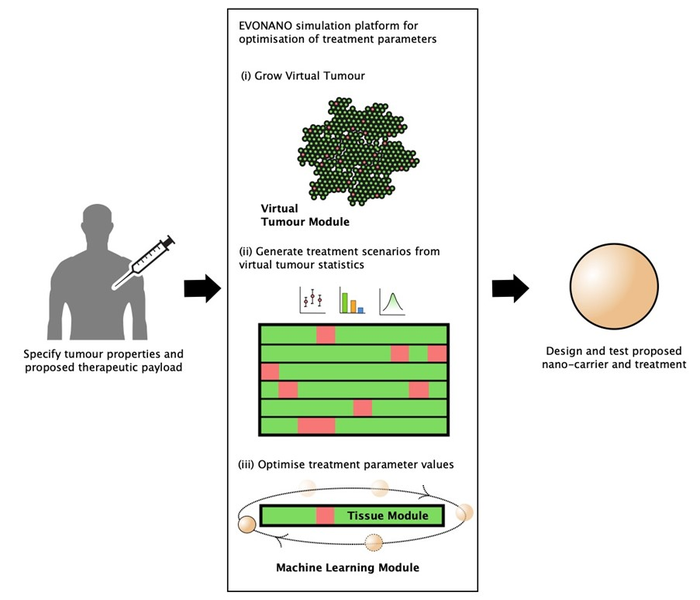Reviewed by Alex SmithSep 22 2021
The EVONANO platform developed at the University of Bristol enables scientists to develop virtual tumors and employ artificial intelligence to make automated optimization of the design of nanoparticles to treat the tumors.
 Diagram showing EVONANO simulation platform for optimization of treatment parameters. Image Credit: EVONANO.
Diagram showing EVONANO simulation platform for optimization of treatment parameters. Image Credit: EVONANO.
The potential to grow and treat virtual tumors is a key stage in developing new cancer therapies. Specifically, researchers can use virtual tumors to enhance nanoparticle-based drug design before they are tested in the laboratory or on patients.
The study titled “Evolutionary computational platform for the automatic discovery of nanocarriers for cancer treatment” was published in the journal Computational Materials, on September 21st, 2021.
The paper is derived from the European project EVONANO performed by Dr. Sabine Hauert and Dr. Namid Stillman from the University of Bristol and is led by Dr. Igor Balaz from the University of Novi Sad.
Simulations enable us to test many treatments, very quickly, and for a large variety of tumours. We are still at the early stages of making virtual tumours, given the complex nature of the disease, but the hope is that even these simple digital tumours can help us more efficiently design nanomedicines for cancer.
Dr. Sabine Hauert, University of Bristol
According to Dr. Hauert, using the software to grow and treat virtual tumors could be useful in the development of targeted cancer treatments.
In the future, creating a digital twin of a patient tumour could enable the design of new nanoparticle treatments specialised for their needs, without the need for extensive trial and error or laboratory work, which is often costly and limited in its ability to quickly iterate on solutions suited for individual patients.
Dr. Sabine Hauert, University of Bristol
Nanoparticle-based drugs exhibit the ability for enhanced targeting of cancer cells. The reason is that nanoparticles are tiny vehicles that can be designed to deliver drugs to tumors. Their design alters their potential to travel in the body and rightly target the cancer cells.
A bioengineer, for instance, may alter the size, charge or material of the nanoparticle; coat the nanoparticles with molecules that enable easy recognition by cancer cells; and load them with various drugs to destroy cancer cells.
The team achieved the simulation of simple tumors and more complex ones with cancer stem cells using the EVONANO platform. These tasks would otherwise be challenging to treat and lead to the relapse of some cancer patients. This technique identified nanoparticles designs that were known to work in earlier research, including prospective new approaches for nanoparticle design.
The tool we developed in EVONANO represents a rich platform for testing hypotheses on the efficacy of nanoparticles for various tumour scenarios. The physiological effect of tweaking nanoparticle parameters can now be simulated at the level of detail that is nearly impossible to achieve experimentally.
Dr. Igor Balaz, University of Novi Sad
The further difficulty is to design the correct nanoparticle. The researchers used a machine learning technique known as artificial evolution to fine-tune nanoparticle design until it is possible to treat all scenarios tested, simultaneously preserving healthy cells to limit possible side effects.
According to the study co-lead author Dr. Namid Stillman, “This was a big team effort involving computational researchers across Europe over the past three years. I think this demonstrates the power of combining computer simulations with machine learning to find new and exciting ways to treat cancer.”
In the future, the researchers look to utilize such a platform to bring digital twins closer to reality by using information from individual patients to develop virtual versions of their tumors and optimize treatments that are desired.
In the nearer future, the platform will be employed to identify new nanoparticle approaches that can be tested in the laboratory. The software is open-source, thereby facilitating other researchers to build their AI-powered cancer nanomedicine.
Dr. Balaz concluded, “To get closer to clinical practice, in our future work we will focus on replicating tumour heterogeneity and drug resistance emergence. We believe these are the most important aspects of why cancer therapy for solid tumours often fails.”
Journal Reference:
Stillman, N. R., et al. (2021) Evolutionary computational platform for the automatic discovery of nanocarriers for cancer treatment. npj Computational Materials. doi.org/10.1038/s41524-021-00614-5.